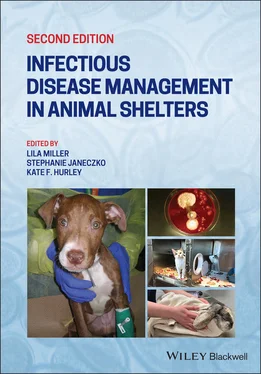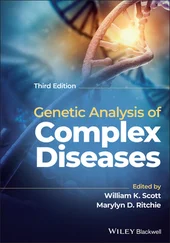Cynthia Karsten, DVM, DABVP (Shelter Medicine Practice)Outreach Veterinarian, UC Davis Koret Shelter Medicine Program UC Davis School of Veterinary Medicine Davis, CA, USA
S. Emmanuelle Knafo, DVM, Dipl. ACZM (Zoological Medicine)Avian and Exotics Department Red Bank Veterinary Hospital Tinton, NJ, USA
Laurie J. Larson, DVMDirector, CAVIDS Titer Testing Service University of Wisconsin School of Veterinary Medicine Madison, WI, USA
Julie K. Levy, DVM, DACVIM, DABVP (Shelter Medicine Practice)Fran Marino Endowed Professor of Shelter Medicine Education Maddie’s Shelter Medicine Program College of Veterinary Medicine University of Florida Gainesville, FL, USA
Annette Litster, BVSc, PhD, FANZCVS (Feline Medicine), MMedSci (Clinical Epidemiology)Senior Veterinary Specialist Zoetis Petcare Chicago, IL, USA
Araceli Lucio‐Forster, PhDLecturer Cornell University College of Veterinary Medicine Ithaca, NY, USA
Lila Miller, BS, DVMVice President, Shelter Medicine (retired) American Society for the Prevention of Cruelty to Animals (ASPCA) New York, NY, USA
Sandra Newbury, DVM, DABVP (Shelter Medicine Practice)Director, University of Wisconsin Shelter Medicine Program Associate Professor, Department of Medical Sciences University of Wisconsin‐Madison School of Veterinary Medicine Madison, WI, USA
Jeanette O’Quin, DVM, MPH, DACVPM, DABVP (Shelter Medicine Practice)Assistant Professor The Ohio State University Columbus, OH, USA
Patricia A. Pesavento, DVM, PhD, DIP ACVPProfessor, Department of Pathology, Microbiology, and Immunology School of Veterinary Medicine, UC Davis Davis, CA, USA
Janet Scarlett, DVM, MPH, PhDEmerita Professor of Epidemiology Founder and Former Director, Maddie’s Shelter Medicine Program Cornell University College of Veterinary Medicine Ithaca, NY, USA
Ronald D. Schultz, PhDEmeritus University of Wisconsin School of Veterinary Medicine Madison, WI, USA
Martha Smith‐Blackmore, DVMAdjunct Assistant Clinical Professor Cummings School of Veterinary Medicine at Tufts University North Grafton, MA; Veterinary Medical Director City of Boston Animal Care and Control Boston, MA, USA
Helen Tuzio, DVM, DABVP [Feline Practice], CVAClinical Associate Professor Long Island University ‐ College of Veterinary Medicine Brookville, NY, USA
G. Robert Weedon, DVM, MPHTLC PetSnip, Inc. Lakeland, FL; Retired Clinical Assistant Professor and Service Head College of Veterinary Medicine, University of Illinois Urbana, IL, USA
The first shelter medicine textbook, Shelter Medicine for Veterinarians and Staff , was published in 2004, five years after the first formal shelter medicine course at a veterinary college was taught at Cornell University in 1999. The preface to the 2009 first edition of Infectious Disease Management in Animal Shelters stated that “shelter medicine is a relatively new specialty area in veterinary medicine.” Much has changed in the past 12 years, with perhaps the most significant change being that the evolution of shelter medicine resulted in it being recognized as a veterinary specialty in 2014. In addition, there are many shelter medicine classes offered as part of the core and elective curriculum of veterinary colleges, as well as internships and residency programs. The animal welfare field has acknowledged and embraced the foundational role that shelter medicine’s core principles of population management, capacity for care, preventive medicine and infectious disease control play in the success of the field as a whole, and their importance in improving and saving individual animal lives. A broad range of animal welfare, veterinary, and even public health organizations have embraced the inclusion of shelter medicine and shelter considerations in guidelines for general management and disease control.
Despite numerous advances in the field, the need for these core foundational strategies persists and the purpose of this textbook remains the same as the first edition, i.e., to provide detailed, useful information regarding fundamental principles of disease control and specific management of the most important diseases encountered in dogs and cats in shelters. The information in this text is based on the authors’ own substantial, practical experience working with shelter populations, as well as the latest research and evidence‐based medicine. While the emphasis throughout is on strategies for the prevention of illness and mitigation of disease spread, pragmatic information on treatment and considerations for adoption are also included. Reflecting on the dynamic nature of sheltering organizations, the populations they serve, and the environment we live in, this edition contains a new chapter on exotic companion mammals. The chapters on vector‐borne, bacterial and protozoal gastrointestinal diseases have been removed, and the zoonosis chapter has been streamlined and no longer includes abbreviated descriptions of the various zoonotic diseases. The editors recognized that an expanding wealth of resources are available to veterinary and sheltering professionals, and other textbooks and websites are available that can provide the latest up‐to‐date details about disease pathogenesis, diagnostic testing and individual animal treatment protocols. The reader is encouraged to use those resources along with this text. Readers are also encouraged to pay particular attention to the introduction, wellness, sanitation and outbreak management chapters, as this information is useful in all shelter situations. As in any practice, final decisions regarding the selection of treatment protocols, compliance with state, federal and local regulations, safe drug use and shelter practices are the responsibility of the veterinarian. The editors hope that this textbook will contribute to the continued improvement of animal health and welfare and the ongoing elevation of sheltering practices across the field.
The editors would like to thank Wiley Blackwell, all our contributing authors, the ASPCA, the UC Davis Koret Shelter Medicine Program and our families, friends and countless colleagues for their support, patience and understanding as we worked to complete this second edition of Infectious Disease Management in Animal Shelters textbook. Contrary to what one might think, editing a second edition is not necessarily easier than the first.
Special thanks must go to Erin Doyle for stepping in to write a chapter and Elise Gingrich for assisting with editing two chapters late in the process of completing this textbook. Brian DiGangi deserves particular recognition for not only helping edit this textbook, but for agreeing to co‐author an additional chapter at the last minute while editing another shelter medicine textbook. Finally, we would like to acknowledge Jennifer Calder, the co‐author of the zoonosis chapter in the first edition. After starting work to revise the chapter for this second edition, Jennifer had to step down to focus on her position as Director of Health of the City of Stamford, Connecticut to manage the COVID 19 pandemic.
1 Introduction to Infectious Disease Management in Animal Shelters
Kate F. Hurley1 and Lila Miller 2
1 UC Davis Koret Shelter Medicine Program, UC Davis School of Veterinary Medicine, Davis, CA, USA
2 American Society for the Prevention of Cruelty to Animals (ASPCA), New York, NY, USA
Though many excellent veterinary texts on infectious disease have been published over the years, the first edition of this book was published in 2009 to fill a gap in understanding the specific challenges and solutions regarding infectious disease management in shelters. The risks in this context are abundant. Animals entering shelters are often unvaccinated, suffering from parasite infestation, poor nutrition and a variety of other stressors. Shelters house lost, unwanted and abused animals spanning every life stage, from neonates to geriatric pets, each with their own unique risks and requirements. Limited resources and outdated facilities, still found at many shelters, increase the difficulty of keeping these vulnerable populations healthy.
Читать дальше












